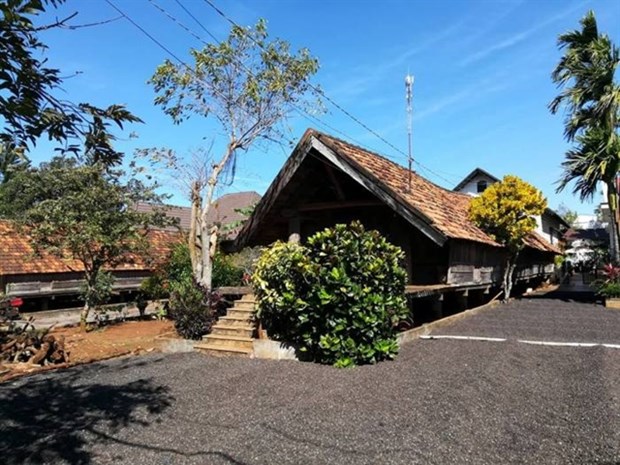of Buon Ma Thuot city, Ako Dhong holds the hidden beauty of a
traditional village of the E De ethnic group.
We were amazed to find a traditional village
still thriving in a modern city.
In the past, Ako Dhong was nothing but
forests. The village patriarch Ama H’rin was the first person
to reclaim the area and turn it into a new land for the E
De ethnic community in 1956.
The tiny village used to have only three long
houses that housed 10 families. Since 1975, villagers have been
building households and a village school.
Now, the 55ha village has around more than 100
households and around 3,000 people who make a living
from brocade, ruou can (wine drunk out of a jar through straws)
and handicraft products.
According to the Ede, “Ako” means upstream
and “Dhong” means valley.
This is easy to explain as the village lies at
the head of Ea Nuol Dtream.
The village has a peaceful vibe, and the roads
are clean and spacious. In front of each long house is a garden with many
trees.
Long houses are part of the architecture of the
E De people. They are an embodiment of the matriarchy and places
where cultural and spiritual values of the E De people are preserved.
These houses, on stilts, are built
from wood and bamboo. They are long enough to house many people, and
residents here seldomly build new houses to replace the old
ones. Instead they just expand the existing structures to make space
for new family members.
One of the most imposing and beautiful long
houses in the village belongs to H.Linh Nie, and cost 3 billion VND
(130,400 USD).
Nie is the owner of several hotels and
restaurants in the village, but her love for tradition made her invest in the
traditional long house.
“Nothing is as happy or warm as living in
a traditional long house,” said Nie.
Coffee is the major crop for Ako Dhong
villagers, with plantations stretching 26 hectares and providing a stable
source of income.
Spring is the best time to visit Ako Dhong, when
all the flowers are in bloom.
We also had the chance to talk about the
local gong culture with artisans and listen to songs about wild
high mountain and thick forests.
The unique tombs also intrigued us.
People here think that when they die, their souls will live on and go on
to live in a better world. Statues are carved to pave the way,
symbolising the ultimate joy of the living and the dead.
The last place we visited was Arul Café. It
is a popular destination not only for tourists but also for Buon Ma Thuot
citizens who love the peaceful space and E De culture.
As an intriguing and untouched minority village,
Ako Dhong has been selected to become a community-based tourism spot in
Dak Lak province.
“Buon Ma Thuot city is setting up a detailed
project and invest infrastructure, with support to renovate long houses, and
resurrect traditional festivals to put the village on the tourism map for
domestic and international visitors,” said Vo Tien Dung, head of the Division
of Culture and Information of Buon Ma Thuot city./.




